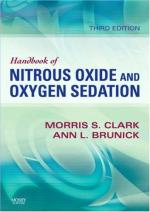|
This section contains 567 words (approx. 2 pages at 300 words per page) |

|
Nitrous oxide, or "laughing gas" (dinitrogen monoxide, N2O) is the only inorganic gas that is practical for clinical anesthetics. It was first synthesized in 1776 by Joseph Priestley and was named "diminished nitrous air." He noted its effects when inhaled, namely, lightheadedness, a mild hysteria, and a diminished sensation to pain, and soon became a novelty at carnivals and parties. In the 1790s, Sir Humphrey Davy noted that nitrous oxide might be helpful in surgical procedures, but his observation went ignored by the medical profession.
By the mid 1800s, however, surgery had advanced to the point where anesthesia was desirable. In 1844, Gardner Q. Colton (1814-1898) an American showman, entrepreneur, and partially trained physician gave a public demonstration of the effects of nitrous oxide which was a financial success. He then began lecturing in other cities. In December 1844, at a Hartford, Connecticut demonstration, Horace Wells, a dentist...
|
This section contains 567 words (approx. 2 pages at 300 words per page) |

|


